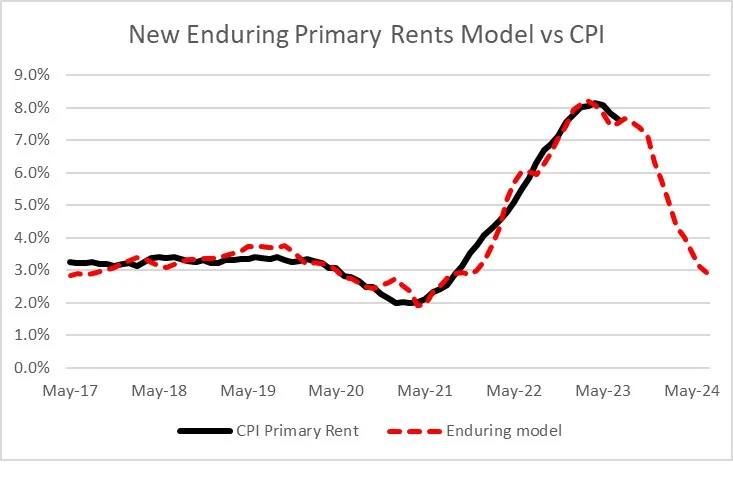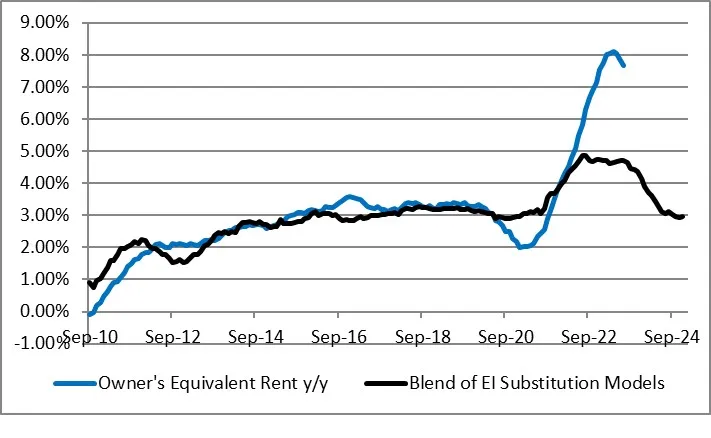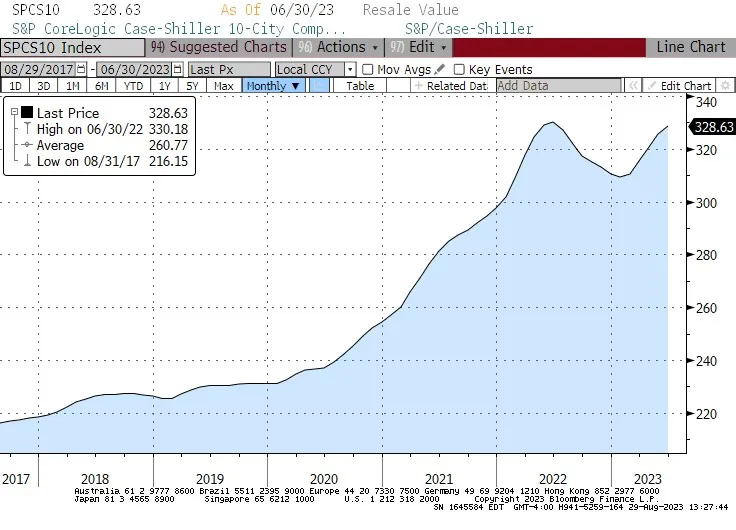As we all know, shelter inflation is very important to the overall rise in the cost of living. Recently, concern about the acceleration in shelter inflation that happened between 2021 and 2023 has been dampened somewhat as the CPI for primary rents and for Owners’ Equivalent Rent have both clearly peaked.

We know that the rent deceleration will slowly unfurl over the next year, and the Fed has recently admitted that this ability to project rent deceleration gives them some comfort on that score. Now, I recently talked in one of my podcasts about why the new models forecasting rent deflation in our relatively near future should be taken with at least a grain, and probably a shaker, of salt…but that being said, both of our models suggest rent inflation may decline to 3% by the second half of 2024, but is unlikely to drop further than that. Our newer, unique model is driven by modeling landlord costs, and it looks very promising.

Our older model has fared worse but with good reason. It overestimated rent inflation in late 2020 into 2021, because the eviction moratorium put pressure on rents but did not affect home prices, and then underestimated inflation thereafter partly because rents had to catch up when the moratorium was lifted.

Although the first model above looks to predict much more tightly (although that’s partly because it’s a new model so we are just now generating out-of-sample data to compare with forecasts), the second model is of interest today. That model uses several different measures of home prices and related series and blends them with different lags to generate the forecast. In other words, this model relies on the behavior of a substitute for rented housing, and that is owned housing. It’s interesting here because it is fairly typical of the way rent inflation has historically been estimated: as (mostly) a lagged function of changes in home prices. If home prices go up, then rents tend to rise because the price of a substitute is rising; if home prices fall, then rents tend to decline because the price of a substitute is falling. Microeconomics 101.
The reason I mention this is because the predictions that rents will be in outright deflation next year are partly driven by the fact that home prices peaked in nominal terms last July, and so year/year home price inflation has declined from about 21% at the peak to slight deflation, in nominal terms, recently (using the S&P Case-Shiller Home Price Index). In real terms, the Case-Shiller HPI dropped about 9% from peak to trough, and around 6% in nominal terms. So, the thought is that the absolute level of rent needs to not only level off but actually decline in order to be consistent with what is happening in the housing market. And, of course, people firmly believe that not only do high-interest rates cause declines in housing activity but also (despite the lack of evidence) in home prices. I’ve been pointing out for a while that that’s not historically true – home prices in the 1970s never declined in nominal terms y/y and mortgage rates were high and variable.
Well, today the S&P Case-Shiller Home Price Index was released and once again surprised to the upside. In nominal terms, home prices are almost back to the highs although they remain a bit below the highs in real terms.


Look, I definitely believe that a recession is in store and we may already be feeling some of it although weakness in China could help hold it at bay for a bit longer. But higher interest rates have actually slowed down some of the home building that was addressing the housing shortage; moreover, in an inflationary environment such as the one we are in right now home prices can fall in real terms without falling in nominal terms. That misunderstanding…that ‘bubbly’ home prices would have to be resolved with a steep decline in nominal home prices…is why at one point the Feb 2024 CME Case-Shiller Home Price Futures contract traded as low as 268. That price implied a 19% nominal decline in home prices from the high, on top of inflation running at 3-5% per year, in a housing-shortage environment! As the Case-Shiller numbers have persistently run far ahead of that worse-than-the-global financial crisis scenario, the futures have slowly pinched higher. But it is amazing to me that, even as nominal home prices are about to reach new highs, the market is pricing in a second decline in prices before a weak multi-year recovery!
Futures markets show where risk clears, not where investors think the price will be in the future. So what this is really saying is that people who want to hedge home prices outnumber those who want to buy homes cheaply. And that’s plausible to me. But it still seems amazing! It also means that the following wind the Fed believes they have from disinflation rents…may not be as strong a wind as they currently expect.
Disclosure: I run a long-only strategy that passively uses this (fairly illiquid) contract, and so I am always net long. But, for what it’s worth, it actually works against my long-run interest to have the longer contracts trade up to make my future rolls more expensive, so hopefully, you’ll all think home prices should be going lower.
